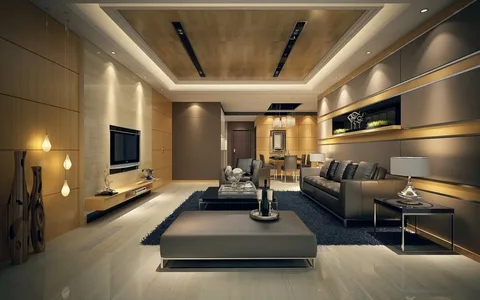In a world dominated by mass production and uniformity, the allure of handcrafted elements in interior design is gaining momentum. Handcrafted pieces bring a unique and personal touch to living spaces, fostering a sense of authenticity and individuality. This article explores the beauty and significance of incorporating handcrafted elements into interior design, delving into the rich tapestry of artisanal inspirations that elevate a home from mere functionality to a haven of artistic expression.
The Timeless Appeal of Handcrafted Pieces:
Handcrafted elements hold an enduring charm that transcends trends and fads. Whether it’s a hand-carved wooden coffee table, a meticulously woven tapestry, or a bespoke ceramic vase, these pieces carry the mark of the artisan’s skill and passion. Unlike mass-produced items, handcrafted pieces are imbued with a sense of history and craftsmanship, adding depth and character to interior designing spaces.
The Personal Touch:
One of the most significant advantages of incorporating handcrafted elements is the ability to infuse a space with a personal touch. Artisans pour their creativity and dedication into each piece, resulting in items that tell a story and reflect a unique perspective. Whether it’s a hand-painted mural, hand-stitched textiles, or hand-thrown pottery, these pieces become more than just decor; they become an extension of the homeowner’s personality and taste.
Cultural Diversity and Connection:
Handcrafted elements often draw inspiration from cultural traditions, bringing a sense of global diversity into interior spaces. From Moroccan rugs to Japanese ceramics, these pieces tell tales of craftsmanship passed down through generations. By integrating handcrafted items from various cultures, homeowners can create a visually rich and culturally connected environment that celebrates the beauty of diversity.
Supporting Artisan Communities:
Incorporating handcrafted elements into interior design also fosters a connection with artisan communities. Choosing handmade goods promotes ethical consumption, supporting skilled artisans and preserving traditional crafts that might otherwise be at risk of fading away. This conscious decision not only enriches your living space but also contributes to the sustainability of artisanal practices around the world.
Versatility in Design:
Handcrafted elements offer unparalleled versatility in design, allowing for a seamless integration into various aesthetics. Whether your style is modern, bohemian, rustic, or eclectic, there are handcrafted pieces that can complement and enhance the overall design scheme. The adaptability of artisanal items makes them suitable for any room, from the living area to the bedroom, kitchen, and even outdoor spaces. Read more: https://lokerown.com/
Types of Handcrafted Elements:
- Woodwork: Hand-carved wooden furniture, sculptures, and accents add warmth and a tactile quality to interiors. Pieces like a handcrafted dining table or a wooden room divider can become focal points that showcase the beauty of natural materials.
- Textiles: Handwoven rugs, embroidered cushions, and hand-stitched quilts bring a sense of coziness and tradition to living spaces. The intricate patterns and textures of artisanal textiles contribute to the visual richness of a room.
- Ceramics: Hand-thrown pottery, artisanal dinnerware, and hand-painted tiles infuse a space with a touch of rustic elegance. The organic shapes and imperfect details of handmade ceramics add character to kitchens and dining areas.
- Metalwork: Hand-forged metal elements, such as custom lighting fixtures or wrought iron accents, provide a sense of industrial chic. The craftsmanship involved in metalworking creates pieces that are not only functional but also visually striking.
- Glasswork: Hand-blown glassware, stained glass windows, or custom glass art pieces introduce a delicate and ethereal quality to interiors. The transparency of glass allows for the play of light, creating captivating visual effects. See this: https://youtube.com/shorts/ir1w611k6ik
Tips for Incorporating Handcrafted Elements:
- Mix and Match: Blend handcrafted pieces with existing decor to create a curated and eclectic look. Avoid a matchy-matchy approach, and instead, embrace the diversity of styles and textures that artisanal items bring.
- Create Focal Points: Use handcrafted pieces strategically to create focal points in a room. Whether it’s a hand-painted mural on a feature wall or a hand-carved headboard, these elements can draw attention and anchor the design.
- Customize and Personalize: Explore the possibility of commissioning custom handcrafted pieces that align with your vision. This ensures a one-of-a-kind item that perfectly suits your space and reflects your personal style.
- Tell a Story: Display handcrafted items with a story to tell. Whether it’s a souvenir from your travels or a piece created by a local artisan, these items become conversation starters and add depth to your home’s narrative.
- Support Local Artisans: Seek out local artisans and craftsmen when adding handcrafted elements to your home. This not only supports the local economy but also allows you to connect with the makers behind the pieces.
Conclusion:
Incorporating handcrafted elements into interior design is a powerful way to infuse your living space with authenticity, personality, and cultural richness. From the tangible warmth of hand-carved wood to the intricate details of artisanal textiles, each piece contributes to the creation of a home that is as unique as its inhabitants. By embracing the beauty of handmade craftsmanship, we not only elevate our surroundings but also become stewards of traditions, supporting artisans and preserving the timeless artistry that enriches our lives.



